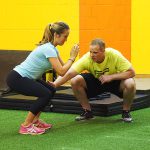Top 3 Coaching Summer Takeaways
Summer is winding down here at F2P, the college and junior hockey athletes are heading back, fall sports season has begun and winter sports testing is happening. As I reflect on the summer, a few performance training topics keep popping into my head as far as lessons reiterated or learned for future programming. The following are my top three.
- This summer I had the opportunity to work with a few new Division 1 athletes and the common trait that they had was they didn’t know how to perform simple movement patterns for their own sport. For example, when I asked a soccer player to describe to me how to accelerate and a volleyball player how to jump, two very fundamental tasks, they couldn’t explain it correctly. Thus, it was no surprise that the way they performed the task needed some major changes. Yes, giving them the knowledge of how to perform the task was as simple as telling and showing them, but the more important change that needed to happen came from the understanding of how performing the task felt, right or wrong, and how to fix it. This will lead to greater results right away. However, if the feeling isn’t ingrained the results often aren’t retained over long periods of time. This is why getting the athlete to feel and be able to talk about their movement is so important.
- Optimal athlete analysis needs to go beyond the numbers. Running a given time, jumping a certain height, or lifting a given amount of weight tells you very little about what needs to be changed. It is the fashion in which the speed was ran, height jump, or amount lifted that will tell you how to make the athlete the best they can be. It is a lesson I was taught by Cal Dietz of the University of Minnesota when I was an intern there and one of the biggest lesson I try to teach all my interns, what can you tell me about the athlete from the way they perform a certain exercise? Thinking this way and making changes in the athlete’s program will allow for the athlete to always have the most optimal program for them personally. For example, this summer I had a 2 Division 1 volleyball players, that play the same position and have similar builds, test pretty close to the same from a number standpoint. However, based on their movements (the way they achieved those results) they had very different strength qualities that need to be addressed. This lead to performing even basic exercises like squats, deadlifts, and core exercises in very different ways. The result…because the athletes were given individualized programs based not just on numbers the athletes got their most optimal results not just average results.
- The actual speed that you are performing your exercises at is vital. This is a debate that goes on often in the strength and conditioning industry. I’m on the side of the actual speed the bar is moving (when talking about a lifting exercise) as one of the most import things to take into account when training for sport performance. A situation that came up at F2P speaks volumes as to why. In the beginning of the summer I had a 265 pound D1 defensive lineman come back from his college lifting program and a 205 pound D1 pitcher that I had been training throughout the HS season. They happened to have had deadlifts measured for speed on the same day. One thing that everyone at F2P can tell you is the football player is obviously stronger (has greater max lifts). However, on this day they were both pulling the weight at the same speed. Why? Because strong doesn’t equal speed or even power for that manner. Having your nervous system fire the correct motor units creates the speed and power the athletes are looking for. And the motor units for the two are very different. Thus, the reason I place a high importance on the actual bar speed, not just the intent of moving the bar fast. Perform a task slow, your teaching the body how to move slow.
As a coach, you can let your athletes go through the motions or you can use these motions to educate and develop yourself and your programs.
“Coaching should be a non-stop learning process” – Nick Pinkelman
Recommended Posts





